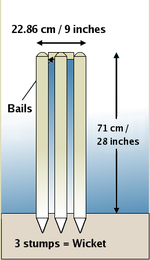Cricket
|
|
Cricket is a team sport played between two groups of eleven players each. It originated in its modern form in England, and is popular mainly in the countries of the Commonwealth. In some countries in South Asia, including India, Pakistan, Bangladesh and Sri Lanka, cricket is by far the most popular sport. Cricket is also a major sport in England and Wales, Australia, New Zealand, South Africa, Zimbabwe and the English-speaking Caribbean (called the West Indies).
The length of the game — a game can last six or more hours a day, for up to five days (and occasionally more) — the numerous intervals for lunch and tea, and the rich terminology are notable aspects which can confuse those not familiar with the sport. For its fans, the sport and the intense rivalries between the top cricketing nations provide passionate entertainment that has occasionally given rise to diplomatic outrage, especially the infamous Bodyline series played between England and Australia.
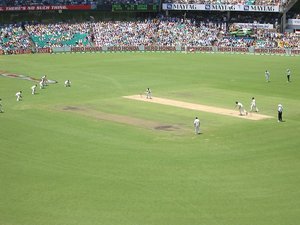
| Contents |
Objective and summary
Cricket is a bat and ball sport. The objective of the game is to score more runs (points) than the opposing team.
A match is divided into innings, during which one team bats while the other team bowls and fields.
In each innings, the bowling team tries to limit the runs scored by the batting team and to get the opposition players out, an event which is described as 'taking a wicket'.
The batting team keeps two batsmen on the field. Each player bats until he is out, and then is replaced and does not bat again in that innings. Once ten of the eleven players of the batting team have been dismissed (i.e., ten wickets have been taken) the team is said to be 'All Out' and their innings comes to an end. A team's innings may also be declared closed by the batting team's captain.
Matches may be played over one or two innings -- that is, one or two turns at bat for each team, so that a "two innings match" contains four innings in total. For most one innings matches such as one-day matches, each team's innings is limited to a set number of overs. An over is a set of six legal (fair) deliveries or balls. This type of match is often called limited-overs cricket.
Conclusion of the match
The first team to bat sets a target score for the second team, which chases the target when it comes to bat. (In a two innings match, the target is the sum of the first- and second-innings scores.) Matches usually end in one of these ways:
- The batting team reaches their target. They are said to have won the match by n wicket(s), where n is the number of additional wickets the opposing team needed to take to bring the innings to an end.
- The batting team is dismissed before they can reach their target. They are said to have lost the match by n run(s), where n is the difference in scores between the teams.
- In two innings matches, the allotted time for the match expires without the batting team either reaching their target or being dismissed. In this case the result is a draw. A team that sets an enormous target but takes a long time over it risks drawing the match by leaving themselves insufficient time to dismiss the other team, which is the reason a captain will often declare his team's innings closed.
- In limited-overs (usually one innings) matches, the second team to bat exceeds the score of the first team before the allotted number of overs are up. In this case, the second team batting wins.
- Also in limited-overs matches, the maximum number of overs available for the second team to bat are used up. In this case, provided the number of runs made by the first team are not exceeded or equalled on the last ball, the second team batting loses.
If, in a two-innings match, the first team to bat are dismissed in their second innings with a combined first- and second-innings score less than the first-innings score of their opponents (a rare occurrence), the match is concluded and they are said to have lost by an innings and n runs, where n is the difference in score between the teams. If the team batting last is dismissed with the scores exactly equal, i.e. they are one run short of their target (an extremely rare occurrence) the match is a tie. If the match has only a single innings per side, with a set number of deliveries, and the match is abandoned without completion due to an impossibility of continuing the play, because of bad weather, unruly crowd or any such unlikely event or situation, the result is declared as No-Result.
See also: The result in cricket
Laws of cricket
Main article: Laws of cricket
The game is played in accordance with 42 laws of cricket, which have been developed by the Marylebone Cricket Club in discussion with the main cricketing nations. Teams may agree to alter some of the rules for particular games. Other rules supplement the main laws and change them to deal with particular circumstances. In particular, there are a number of modifications to the playing structure and fielding position rules that apply to one innings games that are restricted to a set number of fair deliveries.
Players and officials
Main article: Cricketer
Each team consists of eleven players. Depending on his primary skills, a player may be classified as a specialist batsman or bowler. A balanced team usually has five or six specialist batsmen and four or five specialist bowlers. A player who excels in both fields is known as an all-rounder. One player of the team that is currently bowling takes up the role of a wicket-keeper, which is a highly specialised fielding position.
Two on-field umpires preside over a match. One umpire will stand behind the wicket at the end from which the ball is bowled, and adjudicate on most decisions. The other will stand near the fielding position called square leg, which offers a side view of the batsman, and assist on decisions for which he has a better view. In some professional matches, they may refer a decision to an off-field 'third' umpire, who has the assistance of television replays. In international matches an off-field match referee ensures that play is within the laws of cricket and the spirit of the game.
The playing field
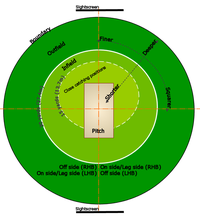 A standard cricket ground, showing the cricket pitch (brown), close-infield (light green) within 15 yards (13.7 m) of the striking batsman, infield (medium green) inside the white 30 yard (27.4 m) circle, and outfield (dark green), with sight screens beyond the boundary at either end. |
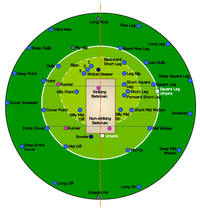 The standard fielding positions in cricket for a right-handed batsman; the positions are reflected for a left-handed batsman. |
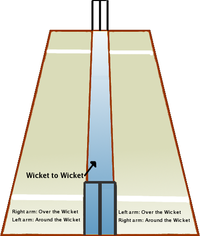 A perspective view of the cricket pitch from the bowler's end. The bowler runs in past one side of the wicket at the bowler's end, either 'over' the wicket or 'round' the wicket. |
| Missing image Cricketpitchmswd.png The Cricket pitch dimensions |
The cricket field consists of a large circular or oval-shaped grassy ground. There are no fixed dimensions for the field but its diameter usually varies between 450 feet (137 m) to 500 feet (150 m). In most stadiums, a rope demarcates the perimeter of the field and is known as the boundary.
- The pitch
Main article: Cricket pitch
Most of the action takes place in the centre of this ground, on a rectangular clay strip usually with short grass called the pitch. The pitch measures 10 × 66 feet (3.05 × 20.12 m).
At each end of the pitch three upright wooden poles, called the stumps, are hammered into the ground. Two wooden crosspieces, known as the bails, sit in grooves atop the stumps, linking each to its neighbour. Each set of three stumps and two bails is collectively known as a wicket. One end of the pitch is designated the batting end where the batsman stands and the other is designated the bowling end where the bowler runs in to bowl.
Lines drawn or painted on the pitch are known as creases. Creases are used to adjudicate the dismissals of batsmen and to determine whether a delivery is fair.
- Parts of the field
For a one-innings match played over a set number of fair deliveries, there are two additional field markings. A painted oval is made by drawing a semicircle of 30 yards (27.4 m) radius from the centre of each wicket with respect to the breadth of the pitch and joining them with lines parallel, 30 yards (27.4 m) to the length of the pitch. This line, commonly known as the circle, divides the field into an infield and outfield. Two circles of radius 15 yards (13.7 m), centred on each wicket and often marked by dots, define the close-infield. The infield, outfield, and the close-infield are used to enforce fielding restrictions.
- Placements of players
Main article: Fielding positions in cricket
The team batting always has two batsmen on the field. One batsman, known as the striker, faces and plays the balls bowled by the bowler. His partner stands at the bowling end and is known as the non-striker. The wicket-keeper stands or crouches behind the wicket at the batting end.
The captain of the fielding team spreads his remaining nine players — the fielders — around the ground to cover most of the area. Their placement may vary dramatically depending on strategy. Each position on the field has a unique label.
Match structure
- The toss
Main article: toss (cricket)
On the day of the match, the captains inspect the pitch to determine the type of bowlers whose bowling would be suited for the offered pitch surface and select their eleven players. The two opposing captains then toss a coin. The captain winning the toss may choose either to bat or bowl first.
- Overs
Each innings is subdivided into overs. Each over consists of six consecutive deliveries bowled by the same bowler. No bowler is allowed to bowl consecutive overs. After the completion of an over, the bowler takes up a fielding position, while another player takes over the bowling.
After every over, the batting and bowling ends are swapped, and the field positions are adjusted. The umpires swap so the umpire at the bowler's end moves to square leg, and the umpire at square leg moves to the new bowler's end.
- End of an innings
Main article: End of an innings (Cricket)
An innings is completed if:
- Ten out of eleven batsmen are 'out' (dismissed).
- A team chasing a given target number of runs to win manages to do so.
- The predetermined number of overs are bowled (in a one-day match only, usually 50 overs).
- A captain declares his innings closed (this does not apply to one-day limited over matches).
- Playing time
Main article: Playing time (cricket)
Typically, two innings matches are played over three to five days with at least six hours of cricket being played each day. One innings matches are usually played over one day for six hours or more. There are formal intervals on each day for lunch and tea, and shorter breaks for drinks, where necessary. There is also a short interval between innings.
The game is only played in dry weather. Additionally, as in professional cricket it is common for balls to be bowled at over 90 mph (144 km/h), the game needs to be played in daylight that is good enough for a batsman to be able to see the ball. Play is therefore halted when it rains (but not usually when it drizzles) and when there is bad light. Some one-day games are now played under floodlights, but, apart from few experimental games in Australia, floodlights are not used in longer games. Professional cricket is generally played outdoors. These requirements mean that in England, Australia, New Zealand, South Africa and Zimbabwe the game is usually played in the summer. In the West Indies, India, Pakistan, Sri Lanka and Bangladesh games are played in the winter. In these countries the hurricane and cyclone season coincides with their summers.
Batting and scoring runs
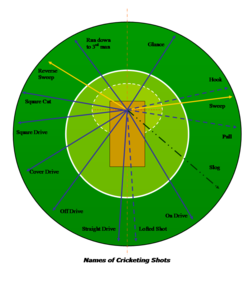
See also: Scoring
- Batting
Main articles: Batsman, Batting
Batsmen stand waiting for the ball at the batting crease. The wooden bat that a batsman uses consists of a long handle and a flat surface on one side. If the batsman hits the ball with his bat, it is called a shot (or stroke). If the ball brushes the side of the bat it is called an edge or snick. Shots are named according to the style of swing and the direction in the field to which the batsman desires to hit the ball. Depending on the team's strategy, he may be required to bat defensively in an effort to not get out, or to bat aggressively to score runs quickly.
Batsmen come in to bat in a batting order, which is determined by the team captain. The first two positions, known as "openers", are generally a specialised position, as they face the most hostile bowling (the opposing team's fast bowlers are at their freshest and the ball is new). After that, the team typically bats in descending order of batting skill, the first five or six batsmen usually being the best in the team. After them the all-rounders follow and finally the bowlers (who are usually not known for their batting abilities). This order may be changed at any time during the course of the game for strategic reasons.
- Run scoring
Main article: Run (cricket)
To score a run, a striker must hit the ball and run to the opposite end of the pitch, while his non-striking partner runs to his end. Both runners must touch the ground behind the popping crease with either his bat or his body to register a run. If the striker hits the ball well enough, the batsmen may double back to score two or more runs. This is known as running between wickets. But there is no tip and run rule, so the batsmen are not required to attempt a run when the ball is hit. If a fielder knocks the bails off the stumps with the ball while no batsman is grounded behind the nearest popping crease, the nearest batsman is run out. If the ball goes over the boundary, then four runs are scored, or six if the ball has not bounced.
- Extras
Main article: Extra (cricket)
Every run scored by the batsmen contributes to the team's total. A team's total also includes a number of runs which are unaccredited to any batsmen. These runs are known as extras, apart from in Australia where they are also called sundries. Extras consist of byes, leg byes, no balls, wides and penalty runs. The former two are runs that can be scored if the batsman misses making contact with bat and ball, and the latter two are types of fouls committed by the bowler. For serious infractions such as tampering with the ball, deliberate time-wasting, and damaging the pitch, the umpires may award penalty extras to the opposition; in each case five runs. A team need not be batting in order to receive penalty extras.
Bowling and dismissals
Cricket_ball_G&M.jpg
- Bowling
Main articles: Bowlers, Bowling, Bowling strategy
A bowler delivers the ball toward the batsmen, using what is known as a bowling action: his arm must not straighten at the elbow during the delivery. If he straightens his arm in any manner, it is an illegal throw and the delivery is called a no-ball. Usually the bowler pitches the ball so that it bounces before reaching the batsman. When bowling, bowlers must release the ball with their entire back foot inside the area bounded by the creases, and so too some part of the front foot inside this area, to prevent it from being called a no-ball. The ball must also be delivered so it is within the batsman's reach, otherwise it is termed a wide.
The bowler's primary goal is to take wickets; that is, to get a batsman out or dismissed. If a bowler can dismiss the more accomplished batsmen on the opposing team he reduces the opportunity for them to score, as it exposes the less skilful batsmen. Their next task is to limit the numbers of runs scored per over they bowl. This is known as the Economy rate. If a bowler gets a batsman out, he is credited for this achievement. There are two main kinds of bowlers : pace bowlers and spin bowlers.
- Dismissal of a batsman
Main article: Dismissal (cricket)
A batsman is allowed to bat as long as he doesn't get out (also known as being dismissed). There are ten ways of being dismissed, some of which are credited as wickets to the bowler, some of which are not credited to any player. If the batsman is dismissed, another player from the batting team replaces him until ten batsmen are out and the innings is over. Only one batsman can be dismissed per ball bowled.
Many modes of dismissal require the wicket to be "put down". The wicket is put down if a bail is dislodged from the top of the stumps or a stump is struck out of the ground either with the ball, or by a fielder with the ball in his hand. Of the following ten modes of dismissal, the first six are common, while the last four are technicalities which rarely occur. Briefly, the ten modes are:
- Caught – When a fielder catches the ball after the batsman strikes it, before the ball bounces.
- Bowled – When a delivered ball hits the stumps at the batters end, and dislodges one or both of the bails.
- Leg before wicket (LBW) – When a delivered ball misses the bat and strikes the leg of the batsman, and the umpire judges that the trajectory would have struck the stumps; certain other criteria may also have to be fulfilled.
- Run out – When a fielder, bowler or wicket-keeper removes one or both of the bails with the ball by hitting the stumps whilst a batsman is still running between the two ends. Not officially credited to any player, though the identities of the fielder or fielders involved may be noted in brackets on the scoreboard.
- Stumped – When the batsman leaves his crease in playing a delivery, voluntarily or involuntarily, but the ball goes to the wicket-keeper who uses it to remove one or both of the bails through hitting the bail(s) or the wicket(s) before the batsman has remade his ground.
- Hit wicket – When the batsman accidently knocks the stumps with either their body or their bat, causing one or both of the bails to be dislodged; either in playing a shot or in taking off for the first run.
- Handled the ball – When the batsman deliberately handles the ball.
- Hit the ball twice – When the batsman hits the ball twice, except in order to use it as a barrier from rolling and striking his stumps.
- Obstructing the field – When a batsman deliberately hinders a fielder from attempting to field the ball.
- Timed out – When a new batsman takes over three minutes to appear on the field to replace a dismissed batsman. (If the delay is even more protracted, the umpires may cause the match to be forfeited.) The bowler is not credited for taking the dismissal.
Additionally, a batsman may leave the field undismissed. For instance, if he is ill or injured, this is known as retired hurt or retired ill. The batsman is not out; he may return to bat later in the same innings if sufficiently recovered. Also, an unimpaired batsman may retire, but it is usual to ask permission of the opposing captain if the batsman wishes to reserve his right to return and continue his innings. In practice, very few batsmen retire.
An individual cannot be out — caught, bowled, 'leg before wicket', stumped, or 'hit wicket' off a no ball. He cannot be out – 'bowled', 'leg before wicket', or 'hit the ball twice' off a wide.
Fielding and wicket-keeping
Main articles: Fielder, Fielding strategy
Fielders assist the bowlers to prevent batsmen from scoring too many runs. They do this in two ways: by taking catches to dismiss a batsman, and by intercepting hit balls and returning them to the pitch to attempt run-outs to restrict the scoring of runs.
Main article: Wicket-keeper
The wicket-keeper is a specialist fielder who stands behind the batsman's wicket throughout the game. His primary job is to gather deliveries that the batsman fails to hit, to prevent them running into the outfield, which would enable batsmen to score byes. To this end, he wears special gloves and pads to cover his lower legs; the only fielder to do so. Due to his position relative directly behind the striker, the wicket-keeper has a good chance of getting a batsman out caught off a fine edge from the bat; thicker edges are typically handled by the "slips" fieldsmen. The wicket-keeper is also the only person who can get a batsman out stumped.
Other roles
- Captain
Main article: Role of a cricket captain
The captain's acumen in deciding the strategy is crucial to the team's success. The captain makes a number of important decisions, including setting field positions, shuffling the bowlers and taking the toss.
- A runner
Main article: runner (cricket)
In the event of a batsman being fit to bat but too injured to run, he may request the umpire and the fielding captain for a runner. The runner chosen must, if possible, be a player who has already been given out. After a batsman hits the ball, the runner's only task is to run between the wickets instead of the injured batsman.
- Substitutes
Main article: Substitute
If a player gets injured or becomes ill during a match, a substitute is allowed to field instead of him. A substitute cannot bowl, bat, or act as a captain or wicket-keeper. A substitute is a temporary role and leaves the field once the injured player is fit to return.
History
Main article: History of cricket
A rudimentary form of the sport can be traced back to the 12th century. Written evidence exists for a sport known as creag being played by Prince Edward, the son of Edward I, in England in around 1300. In 1598 there was a reference to the sport of cricket being played by boys at the Royal Grammar School, Guildford. This is generally considered to be the first mention of cricket in the English language. A number of words are thought to be possible sources for the term cricket. The name may derive from a term for the cricket bat: old French criquet (meaning a kind of club) or Flemish krick(e) (meaning a stick) or in old English cricc or cryce (meaning a crutch or staff). Alternatively, the French criquet apparently derives from the Flemish word krickstoel, which is a long low stool on which one kneels in church and which resembles the long low wicket with two stumps used in early cricket.
From the mid-17th to the 18th century, cricket transformed from being a children's game to one played by men for bets. Old Coulsdon hosted the first ever cricket match with three stumps and two bails. The Coulsdon and Caterham Team were a pretty confident bunch, laying out a bullish all-comers challenge in 1731 to beat any 11 men in England. Around 1750, a cricket club was formed in Hambledon, Hampshire. In 1788, the Marylebone Cricket Club framed the first set of rules to govern matches played between English counties.
Cricket entered an epochal era in 1961, when English counties modified the rules to provide a variant match form that produced an expedited result: games with a restricted number of overs per side. This gained widespread popularity and resulted in the birth of one-day international (ODI) matches in 1971. The governing International Cricket Council quickly adopted the new form and held the first ODI Cricket World Cup in 1975. Since then, ODI matches have gained mass spectatorship, at the expense of the longer form of the game and to the consternation of fans who prefer the longer form of the game. As of the early 2000s, however, the longer form of cricket is experiencing a growing resurgence in popularity.

